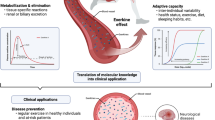Abstract
ALTHOUGH there is a paucity of direct supporting evidence for the postulate that the immediate source of the energy for muscular contraction is the dephosphorylation of adenosine triphosphate, this view has been accepted by most authors1–3. The usual finding that there is no net decrease in the amount of adenosine triphosphate present in the working muscle is attributed to its rapid resynthesis by transfer of the phosphate group of phosphocreatine. However, Fleckenstein et al. 4 found no evidence for such transfers of phosphate groups in a tracer study on drug-induced contracture of muscles of the frog, and Dixon and Sacks5 found no evidence for equilibration of isotopic phosphorus between the terminal phosphorus of adenosine triphosphate and phosphocreatine in the course of a tetanic contraction of the cat gastrocnemius muscle of 30 sec. duration. Nor was there any equilibration of the isotope between the middle phosphorus of adenosine triphosphate and the corresponding phosphorus of adenosine diphosphate, such as would be expected to result from mixing of any adenosine diphosphate formed during the tetanus with that initially present in the resting muscle.
This is a preview of subscription content, access via your institution
Access options
Subscribe to this journal
Receive 51 print issues and online access
$199.00 per year
only $3.90 per issue
Buy this article
- Purchase on Springer Link
- Instant access to full article PDF
Prices may be subject to local taxes which are calculated during checkout
Similar content being viewed by others
References
Szent-Györgyi, A., “Chemistry of Muscular Contraction”, 2nd ed. (Academic Press, New York, 1951).
Weber, H. H., and Portzehl, H., “Progress in Biophysics and Biophysical Chemistry”, 4, 60 (1954).
Buchthal, F., Svensmark, O., and Rosenfalck, P., Physiol. Rev., 36, 503 (1956).
Fleckenstein, A., Janke, J., Davies, R. E., and Richter, W., Arch. Exp. Path. u. Pharm., 228, 596 (1956).
Dixon, G. J., and Sacks, J., Amer. J. Physiol., 193, 129 (1958).
Author information
Authors and Affiliations
Rights and permissions
About this article
Cite this article
SACKS, J. Prolonged Muscular Activity without Phosphate Exchange. Nature 183, 825–826 (1959). https://doi.org/10.1038/183825b0
Issue Date:
DOI: https://doi.org/10.1038/183825b0
Comments
By submitting a comment you agree to abide by our Terms and Community Guidelines. If you find something abusive or that does not comply with our terms or guidelines please flag it as inappropriate.



